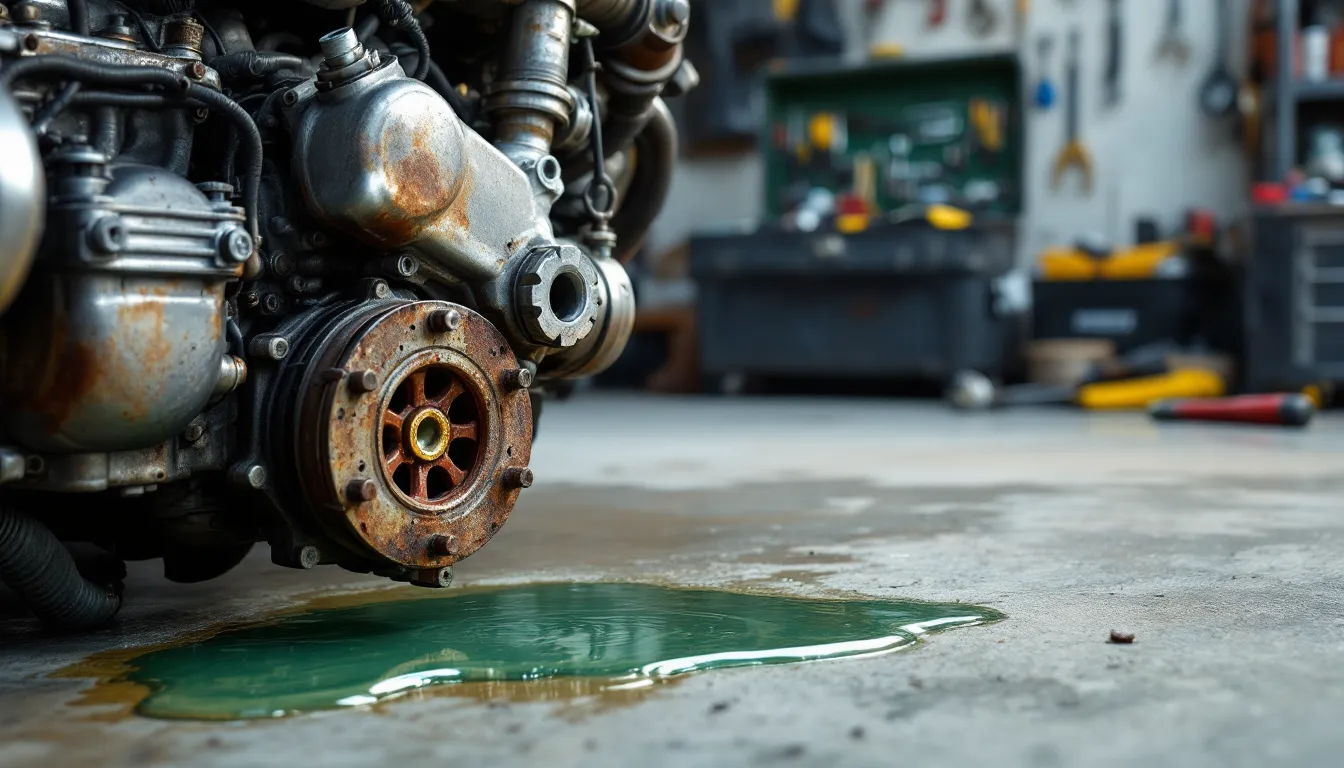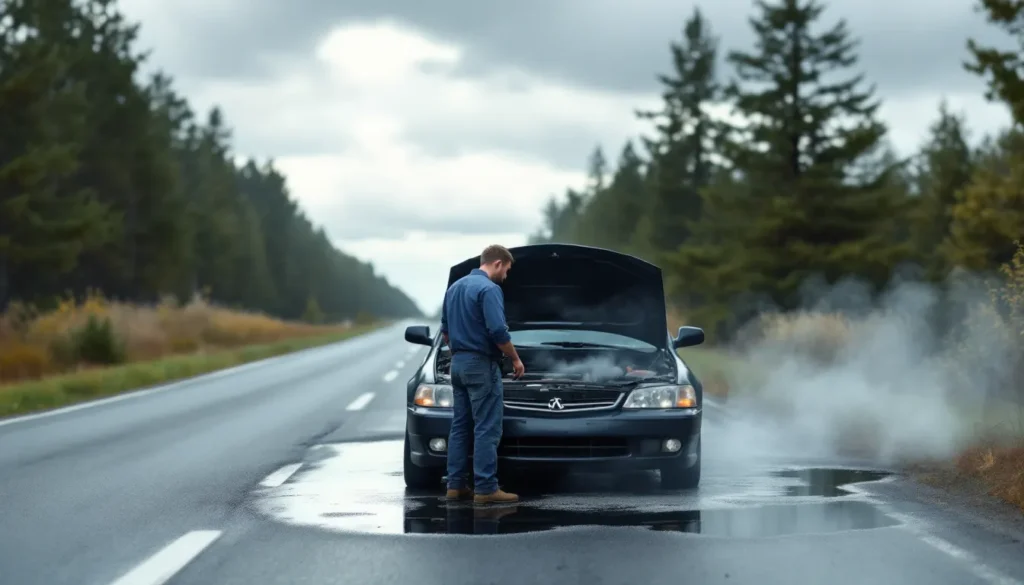Key Takeaways
- Importance of Water Pump: The water pump is essential for circulating coolant, maintaining optimal engine temperatures, and preventing overheating.
- Signs of Failure: Look out for symptoms such as overheating engines, coolant leaks, and unusual noises, which indicate potential water pump malfunction.
- Immediate Actions: If the water pump fails while driving, pull over safely, turn off the engine, and assess for warning lights or coolant leaks to minimize damage.
- Consequences of Failure: A failing water pump can lead to severe engine overheating and damage to other components, resulting in costly repairs if not addressed promptly.
- Preventative Maintenance: Regular inspections, timely coolant changes, and monitoring engine performance can help prevent water pump failure and maintain vehicle reliability.
- Quality Parts: Always use high-quality, OEM parts when replacing the water pump or related components to ensure the cooling system’s effectiveness.
Imagine cruising down the highway when suddenly your engine starts to overheat. You glance at the temperature gauge and realize your water pump might be failing. This crucial component plays a key role in keeping your engine cool, and when it goes out while driving, it can lead to serious consequences.
Ignoring the signs of a failing water pump can turn a minor inconvenience into a major headache. Overheating can cause engine damage, leading to costly repairs and even leaving you stranded on the side of the road. Understanding the symptoms and implications of a failing water pump can help you stay ahead of potential issues and keep your vehicle running smoothly.
Understanding The Water Pump Function
The water pump circulates coolant through the engine and radiator, maintaining optimal operating temperatures. The pump relies on a belt system, usually connected to the engine crankshaft, to facilitate this circulation.
The coolant absorbs heat from the engine, flowing into the radiator where it dissipates heat. This process prevents overheating and allows the engine to function efficiently. The water pump’s consistent operation is crucial for effective cooling in internal combustion engines.
When the water pump fails, coolant circulation stops. This can lead to engine overheating, increased friction, and eventual engine damage. Symptoms of a failing water pump include:
- Coolant leaks: Puddles under the vehicle may indicate a leak from the pump’s seal or housing.
- Overheating engine: Temperature gauges may rise, signaling potential failure.
- Unusual noise: Grinding or squeaking sounds could indicate a worn-out bearing within the pump.
Regular maintenance checks can help you identify issues early, ensuring the water pump operates correctly and preventing costly repairs down the line.
Signs That Your Water Pump Is Failing

Detecting early symptoms of a failing water pump can prevent significant engine damage. Pay attention to these key signs:
Overheating Engine
An overheating engine signals trouble with the water pump or cooling system. If the temperature gauge rises above normal, the water pump may be malfunctioning. The failure prevents coolant from circulating, leading to higher engine temperatures. Gauge readings that consistently climb into the red zone require immediate attention.
Coolant Leaks
Coolant leaks indicate potential issues with the water pump. Look for puddles under the vehicle, often green, orange, or pink fluid. Check for wet spots around the water pump area as this can signify a worn-out seal or connection. Promptly addressing leaks helps maintain proper coolant levels and engine temperature.
Unusual Noises
Unusual noises can suggest water pump failure. Listen for whining or grinding sounds when the engine runs. These noises may signal problems such as worn bearings or loose fittings. Catching these sounds early can prevent further complications and extensive repairs.
Immediate Consequences Of A Failing Water Pump
When a water pump fails while driving, immediate consequences can arise, impacting engine performance and safety. Recognizing these effects can help you respond effectively to prevent further complications.
Engine Overheating
Engine overheating occurs quickly when the water pump malfunction stops coolant circulation. When this happens, the engine temperature rises rapidly. As the temperature gauge climbs beyond the normal range, critical engine parts can warp or seize. Signs like steam rising from the hood or an illuminated warning light indicate severe overheating. If you don’t pull over immediately, extensive damage may occur, leading to costly repairs or engine replacement.
Damage To Other Components
Damage to other components happens as the failing water pump causes overheating. The increased heat can weaken gaskets and seals, leading to coolant leaks. Additionally, the excessive friction can cause wear on engine bearings and other internal components. If the overheating persists, it may also damage the radiator and hoses. This cascading failure can lead to a breakdown of the entire cooling system, requiring extensive repairs. Protect your vehicle by addressing water pump issues promptly.
What To Do If Your Water Pump Fails While Driving
If your water pump fails while driving, acting quickly minimizes potential damage. Follow these steps to ensure safety and assess the vehicle’s condition.
Pulling Over Safely
- Stay Calm: Remain composed to make clear decisions.
- Look for a Safe Spot: Identify a safe area on the side of the road to pull over.
- Signal Your Intentions: Use your turn signal to indicate where you’re going.
- Slow Down Gradually: Reduce your speed smoothly to avoid losing control.
- Avoid Stopping in Traffic: Pull off the roadway and away from moving vehicles.
Assessing The Situation
- Turn Off the Engine: Once stopped, switch off the engine immediately to prevent further damage.
- Check for Warning Lights: Look for any illuminated dashboard warning lights indicating overheating.
- Inspect for Leaks: Examine the ground beneath your vehicle for any signs of coolant leaks.
- Look for Steam: Notice if steam is escaping from the hood; this indicates overheating.
- Wait for the Engine to Cool: Allow the engine to cool for at least 30 minutes before opening the hood to avoid burns.
By following these steps, you can handle a failing water pump incident effectively and minimize potential harm to your engine.
Preventative Measures For Water Pump Failure
Monitoring your vehicle’s cooling system regularly helps prevent water pump failure. Look for any signs of leaks, strange noises, or changes in engine temperature. Maintain proper coolant levels to ensure efficient circulation.
- Schedule Regular Inspections
Schedule routine checks, ideally every 30,000 miles or as recommended by your manufacturer. These inspections include examining the water pump, hoses, and overall cooling system.
- Change Coolant Promptly
Change the coolant according to your vehicle’s maintenance schedule. Fresh coolant prevents corrosion and helps maintain optimal operating temperatures.
- Check Drive Belts
Inspect drive belts for wear and tear. Replace frayed or cracked belts immediately. A healthy belt system ensures proper water pump operation.
- Address Overheating Issues
Address any signs of overheating immediately. This could indicate a problem with the water pump or another component of the cooling system.
- Use Quality Parts
When replacing your water pump or other cooling system components, use high-quality, OEM (Original Equipment Manufacturer) parts to ensure reliability.
- Monitor Engine Performance
Pay attention to changes in engine performance, such as poor acceleration or unusual noises. These could indicate underlying water pump issues.
Implementing these preventative measures keeps your vehicle’s cooling system in peak condition, reducing the likelihood of water pump failure.
Conclusion
Taking care of your vehicle’s water pump is crucial for maintaining engine health. If you notice any signs of failure like leaks or unusual noises don’t ignore them. Addressing these issues promptly can save you from severe overheating and costly repairs down the line.
Regular maintenance checks are your best defense against unexpected breakdowns. By staying proactive and scheduling inspections you can ensure your water pump and cooling system function properly. This way you’ll keep your engine running smoothly and avoid the stress of a roadside emergency. Remember that a little attention now can lead to big savings later.

Hi, I’m Md Rofiqul, a gardening enthusiast who loves spending time in the garden and backyard. I enjoy caring for plants, growing flowers and vegetables, and creating a green space that feels peaceful and refreshing. Gardening is more than just a hobby, it’s a passion that connects me to nature and brings joy to my daily life. Living with plants inspires me to embrace simplicity, patience, and sustainability while making every day more colorful and rewarding.
